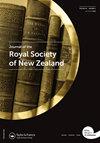Aotearoa's linguistic landscape: exploring the use of te reo Māori in English-medium early childhood education
IF 2.1
4区 综合性期刊
Q2 MULTIDISCIPLINARY SCIENCES
引用次数: 0
Abstract
This research provides insight into current te reo Māori (the Indigenous language of Aotearoa, New Zealand) use in English-medium ECE settings. We videoed naturalistic conversations between kaiako (educators) and tamariki (aged 15–28 months) at 24 English-medium BestStart ECE centres. Te reo Māori was quantitatively assessed across five routines: kai (food) time, book time, group time, free play, and nappy change. The highest rates of te reo Māori use per minute were observed during the kai time, book time, and group time routines, respectively, and lowest during free play and nappy change. Although scripted/prepared te reo Māori use (e.g. karakia and waiata; prayer and song) were well used, opportunities for more complex and elaborate te reo Māori use remain. This research provides insight into the current use of te reo Māori in English-medium ECE settings, an enhanced understanding of kaiako contributions to te reo Māori revitalisation goals, and applications for practice.奥特罗亚的语言景观:探索Māori在英语媒介幼儿教育中的应用
这项研究提供了当前reo Māori(新西兰奥特罗阿土著语言)在英语媒介的欧洲经委会环境中的使用情况。我们在24个英媒BestStart ECE中心拍摄了kaiako(教育者)和tamariki(15-28个月大的孩子)之间的自然对话。reo Māori在五个常规中进行了定量评估:kai(食物)时间,读书时间,小组时间,自由玩耍和换尿布。在玩耍时间、读书时间和小组时间,每分钟使用reo Māori的比例最高,而在自由玩耍和换尿布时,每分钟使用reo Māori的比例最低。虽然有脚本/准备的reo Māori使用(例如karakia和waiata;祈祷和诗歌)被很好地使用,更复杂和精心设计的reo Māori使用的机会仍然存在。本研究提供了对reo Māori在英语媒介欧洲经委会设置中的当前使用的见解,加深了对kaiako对reo Māori振兴目标的贡献的理解,以及实践的应用。
本文章由计算机程序翻译,如有差异,请以英文原文为准。
求助全文
约1分钟内获得全文
求助全文
来源期刊

Journal of the Royal Society of New Zealand
综合性期刊-综合性期刊
CiteScore
4.60
自引率
0.00%
发文量
74
审稿时长
3 months
期刊介绍:
Aims: The Journal of the Royal Society of New Zealand reflects the role of Royal Society Te Aparangi in fostering research and debate across natural sciences, social sciences, and the humanities in New Zealand/Aotearoa and the surrounding Pacific. Research published in Journal of the Royal Society of New Zealand advances scientific knowledge, informs government policy, public awareness and broader society, and is read by researchers worldwide.
 求助内容:
求助内容: 应助结果提醒方式:
应助结果提醒方式:


